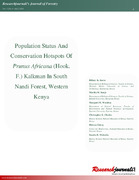| dc.contributor.author | Koros, Hillary | |
| dc.contributor.author | Konje, Martha | |
| dc.contributor.author | Wambua, Margaret | |
| dc.contributor.author | Chesire, Christopher | |
| dc.contributor.author | Odeny, Dickens | |
| dc.contributor.author | Malombe, Itambo | |
| dc.date.accessioned | 2019-05-06T10:23:29Z | |
| dc.date.available | 2019-05-06T10:23:29Z | |
| dc.date.issued | 2016-07-01 | |
| dc.identifier.uri | http://www.researchjournali.com/pdf/2884.pdf | |
| dc.identifier.uri | http://erepository.kibu.ac.ke/handle/123456789/845 | |
| dc.description.abstract | Prunus africanais assessed as vulnerable globally by the International Union for Conservation of Nature. The conservation status is however general and under-illustrated. It lacks details on the actual threats that cause precarious spatial distribution of the population in certain localities such as South Nandi Forest, Western Kenya. This study assessed thepopulation structure of P. africanaby correlation of biometric variable including Diameter at Breast Height and height class distribution and regeneration with the diversity and frequency of threats in spatial context of the plant species. Stratified Random Sampling was used to establish three belttransects of 400 m by 2 km within the forest and 1 km buffer zone in farmlands. The measure of mean, spread, normal distribution and correlation of biometric variables of P. africana was analysed using PAST (Version 4.3). Population structure was summarised using histograms and bar charts. Frequency distribution table was used to analyse the number of incidence of the threats to P. africanaat plot level. T-test was used to test for differences in P. africanaparameters among transects. The spatial distribution model of P. africanain the forest and buffer zone was mapped using the maximum entropy suitability mapping methodas implemented in MAXENT software(Version 3.3.3k) and QGIS Brighton (version 2.6). Prunus africanapopulation was highly concentrated in North eastern part of the forest and surrounding farmlands with admirable number of mature individuals. The Diameter at Breast Height distribution ofP. africanain the forest showed unstable and intermittent population structure unlike a stable population in the surrounding farmlands. Although the seeds germinated profusely, there was poor establishment and survival.Key conservation threats were overgrazing, firewood collection, logging and charcoal burning. The study recommends both in-situand ex-situconservation measures.Keywords: multipurpose, overgrazing, regeneration, vulnerable | en_US |
| dc.language.iso | en | en_US |
| dc.publisher | Researchjournali’s Journal of Forestry | en_US |
| dc.rights | Attribution-NonCommercial-ShareAlike 3.0 United States | * |
| dc.rights.uri | http://creativecommons.org/licenses/by-nc-sa/3.0/us/ | * |
| dc.subject | multipurpose | en_US |
| dc.subject | overgrazing | en_US |
| dc.subject | regeneration | en_US |
| dc.subject | vulnerable | en_US |
| dc.title | Population status and conservation hotspots of Prunus Africana (Hook. F.) Kalkman in South Nandi Forest, Western Kenya | en_US |
| dc.type | Article | en_US |

